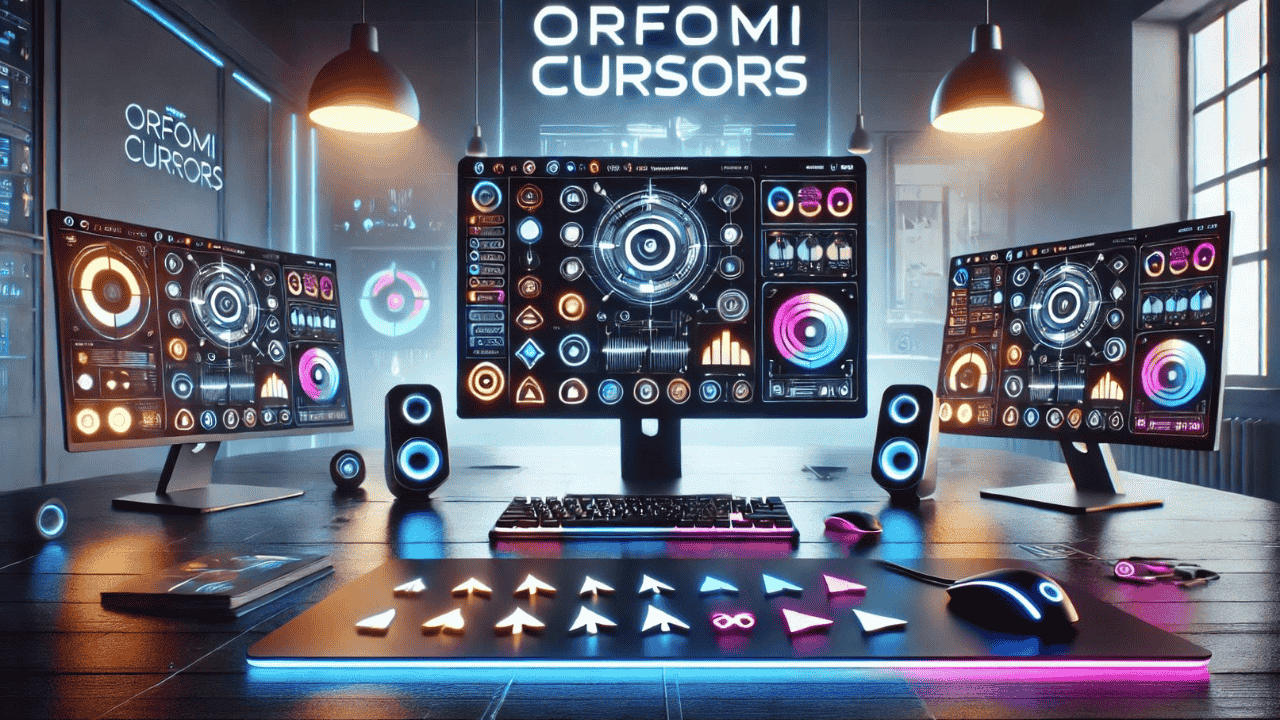Orfomi Cursors: Revolutionizing Human-Computer Interaction
Table of Contents
- Introduction to Orfomi Cursors
- The Evolution of Computer Cursors
- What Are Orfomi Cursors?
- How Orfomi Cursors Work
- Key Features of Orfomi Cursors
- Applications of Orfomi Cursors
- Benefits of Using Orfomi Cursors
- Challenges and Limitations
- The Future of Orfomi Cursors
- How to Get Started with Orfomi Cursors
- Conclusion
Introduction to Orfomi Cursors
In the ever-evolving landscape of human-computer interaction, a groundbreaking technology has emerged that promises to revolutionize the way we interact with digital interfaces. Enter the world of Orfomi cursors – a cutting-edge innovation that combines artificial intelligence, gesture recognition, and predictive algorithms to create a more intuitive and efficient user experience.
As we delve into the intricacies of Orfomi cursors, we’ll explore their origins, functionality, and potential impact on various industries. Whether you’re a tech enthusiast, a UX designer, or simply curious about the future of digital interaction, this comprehensive guide will provide you with everything you need to know about this exciting technology.
The Evolution of Computer Cursors
Before we dive into the specifics of Orfomi cursors, it’s essential to understand the historical context of cursor technology:
- 1960s: The first computer mouse and cursor are invented by Douglas Engelbart.
- 1970s-1980s: Graphical User Interfaces (GUIs) become more prevalent, popularizing cursor-based interaction.
- 1990s-2000s: Touchpads and trackballs offer alternative cursor control methods.
- 2010s: Touchscreens and gesture controls begin to supplement traditional cursors.
- 2020s: AI-enhanced cursors, including Orfomi technology, emerge as the next frontier.
This evolution highlights the continuous quest for more natural and efficient ways to interact with computers. Orfomi cursors represent the latest leap forward in this ongoing journey.
What Are Orfomi Cursors?
Orfomi cursors are an advanced form of computer interface control that utilizes a combination of technologies to create a more intuitive and responsive cursor experience. The term “Orfomi” is derived from “Organic Flow Mimicry,” reflecting the technology’s ability to mimic the organic, flowing movements of human gestures.
At its core, an Orfomi cursor is:
- An AI-powered cursor system
- Capable of learning and adapting to individual user behaviors
- Designed to predict user intentions and streamline interactions
- Able to work across multiple devices and platforms seamlessly
Unlike traditional cursors that simply respond to direct input, Orfomi cursors actively anticipate user needs and adjust their behavior accordingly. This proactive approach marks a significant shift in how we conceptualize human-computer interaction.
How Orfomi Cursors Work
The functionality of Orfomi cursors is based on a complex interplay of several technologies:
- Artificial Intelligence: Machine learning algorithms analyze user behavior patterns to predict intentions and optimize cursor movement.
- Computer Vision: Advanced cameras track hand and eye movements, allowing for precise gesture recognition.
- Haptic Feedback: Subtle vibrations or resistance in input devices provide tactile cues to users.
- Predictive Algorithms: Based on context and historical data, the cursor anticipates likely user actions.
- Adaptive Interfaces: The surrounding UI dynamically adjusts based on cursor behavior and predicted user needs.
These components work in concert to create a cursor that feels like a natural extension of the user’s intentions, rather than a tool that needs to be consciously controlled.
Key Features of Orfomi Cursors
Orfomi cursors boast a range of innovative features that set them apart from traditional cursor systems:
- Gesture Prediction: The cursor begins moving towards a likely target before the user completes their gesture.
- Multi-Device Synchronization: Cursor behavior is consistent across all devices linked to a user’s profile.
- Contextual Shape-Shifting: The cursor’s appearance changes based on the current task or application.
- Intelligent Snapping: The cursor automatically aligns with UI elements it predicts the user wants to interact with.
- Velocity Adaptation: Cursor speed adjusts in real-time based on the precision required for the current task.
- Error Prevention: The system recognizes and corrects potential misclicks before they occur.
- Personalized Shortcuts: Custom gestures can be created for frequently performed actions.
These features combine to create a more efficient, personalized, and user-friendly interface experience.
Applications of Orfomi Cursors
The versatility of Orfomi cursors makes them suitable for a wide range of applications across various industries:
- Graphic Design and Digital Art
- Precise control for intricate designs
- Intuitive tool selection and parameter adjustment
- Video Editing and Animation
- Streamlined timeline navigation
- Effortless keyframe manipulation
- Gaming
- Enhanced aiming and character control
- Reduced input lag for competitive gaming
- Data Analysis and Visualization
- Quick data point selection and comparison
- Efficient navigation of complex dashboards
- Medical Imaging
- Accurate region-of-interest selection in scans
- Improved efficiency in diagnostic processes
- 3D Modeling and CAD
- Intuitive object manipulation in 3D space
- Streamlined parameter adjustments for model refinement
- Accessibility Solutions
- Improved interface control for users with motor impairments
- Customizable input methods for diverse needs
- Virtual and Augmented Reality
- Natural interaction with virtual objects
- Seamless transitions between real and virtual interfaces
These applications demonstrate the potential of Orfomi cursors to enhance productivity and user experience across a broad spectrum of digital activities.
Benefits of Using Orfomi Cursors
The adoption of Orfomi cursor technology offers numerous advantages:
- Increased Productivity: By anticipating user actions and streamlining interactions, Orfomi cursors can significantly reduce the time required to complete tasks.
- Reduced Physical Strain: The intelligent movement of Orfomi cursors minimizes unnecessary hand movements, potentially decreasing the risk of repetitive strain injuries.
- Enhanced Precision: The adaptive nature of the cursor allows for greater accuracy in detailed work, benefiting fields like graphic design and medical imaging.
- Improved Accessibility: The customizable nature of Orfomi cursors makes digital interfaces more accessible to users with various physical abilities.
- Seamless Multi-Device Experience: The ability to maintain consistent behavior across devices creates a more unified user experience in our increasingly connected digital ecosystems.
- Faster Learning Curve: As the cursor adapts to individual user behavior, it becomes easier for new users to become proficient with complex software.
- Reduced Cognitive Load: By predicting and automating certain actions, Orfomi cursors allow users to focus more on their core tasks rather than interface manipulation.
These benefits highlight the potential of Orfomi cursors to not only improve individual user experiences but also to enhance overall digital workflow efficiency.
Challenges and Limitations
While Orfomi cursors offer exciting possibilities, they also face several challenges:
- Privacy Concerns: The data collection required for personalization raises questions about user privacy and data security.
- Learning Curve: Some users may initially find the predictive behavior of Orfomi cursors disorienting or frustrating.
- Hardware Requirements: The advanced features of Orfomi cursors may require specialized hardware, limiting their accessibility.
- Compatibility Issues: Existing software may need significant updates to fully support Orfomi cursor functionality.
- Over-Reliance: Users might become too dependent on predictive features, potentially hampering their ability to use traditional interfaces.
- Cost: The advanced technology behind Orfomi cursors could make them prohibitively expensive for widespread adoption.
- Ethical Considerations: The use of AI in cursor technology raises questions about autonomy and the extent to which computers should anticipate and influence user actions.
Addressing these challenges will be crucial for the widespread adoption and success of Orfomi cursor technology.
The Future of Orfomi Cursors
As Orfomi cursor technology continues to evolve, we can anticipate several exciting developments:
- Brain-Computer Interfaces: Future iterations may incorporate direct neural inputs, allowing for even more intuitive control.
- Emotional Recognition: Cursors could adapt their behavior based on the user’s emotional state, detected through facial recognition or biometric data.
- Collaborative Cursors: In shared digital spaces, multiple Orfomi cursors could interact and collaborate on tasks.
- Augmented Reality Integration: Orfomi cursors could bridge the gap between physical and digital interactions in AR environments.
- Haptic Holography: Advanced haptic feedback could allow users to “feel” digital objects manipulated by Orfomi cursors.
- Adaptive UI Generation: Orfomi cursors could influence the entire user interface, dynamically generating optimal layouts for each task.
- Cross-Application Intelligence: Cursors could maintain context and functionality seamlessly across different software and platforms.
These potential advancements suggest that Orfomi cursors are just the beginning of a new paradigm in human-computer interaction.
How to Get Started with Orfomi Cursors
For those interested in exploring Orfomi cursor technology, here are some steps to get started:
- Research Compatible Hardware: Check if your current devices support Orfomi cursor technology or if upgrades are necessary.
- Update Your Operating System: Ensure you have the latest OS version that includes Orfomi cursor support.
- Download Orfomi Software: Install the necessary drivers and software from reputable sources.
- Calibrate Your System: Follow the setup process to personalize the cursor to your movements and preferences.
- Start with Basic Applications: Begin using Orfomi cursors with familiar software to get accustomed to their behavior.
- Explore Advanced Features: Gradually incorporate more complex gestures and predictive features into your workflow.
- Join User Communities: Connect with other Orfomi cursor users to share tips and experiences.
- Provide Feedback: As an emerging technology, your input can help shape the future development of Orfomi cursors.
Remember that there may be a learning curve as you adapt to this new technology. Patience and practice will help you fully leverage the capabilities of Orfomi cursors.
Conclusion
Orfomi cursors represent a significant leap forward in the field of human-computer interaction. By combining artificial intelligence, gesture recognition, and predictive algorithms, they offer a more intuitive, efficient, and personalized way to interact with digital interfaces.
While challenges remain in terms of privacy, compatibility, and widespread adoption, the potential benefits of Orfomi cursors are substantial. From increasing productivity and reducing physical strain to enhancing accessibility and enabling new forms of digital interaction, this technology has the power to transform how we work, create, and communicate in digital spaces.
As Orfomi cursors continue to evolve, they may well become an integral part of our digital lives, seamlessly bridging the gap between human intention and computer action. Whether you’re a technology enthusiast, a professional in a cursor-intensive field, or simply someone interested in more efficient computing, keeping an eye on the development of Orfomi cursors could provide valuable insights into the future of human-computer interaction.
The journey of cursor technology from its humble beginnings to the AI-powered Orfomi cursors of today is a testament to our ongoing quest for more natural and intuitive ways to interact with machines. As we stand on the brink of this new era in digital interaction, one thing is clear: the way we point and click will never be the same again.







